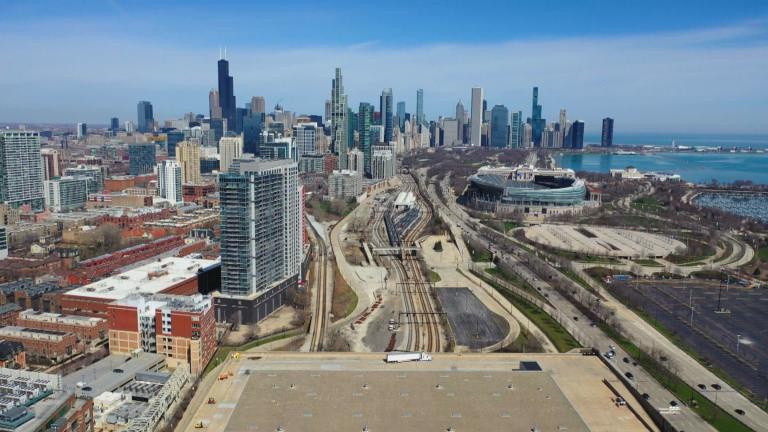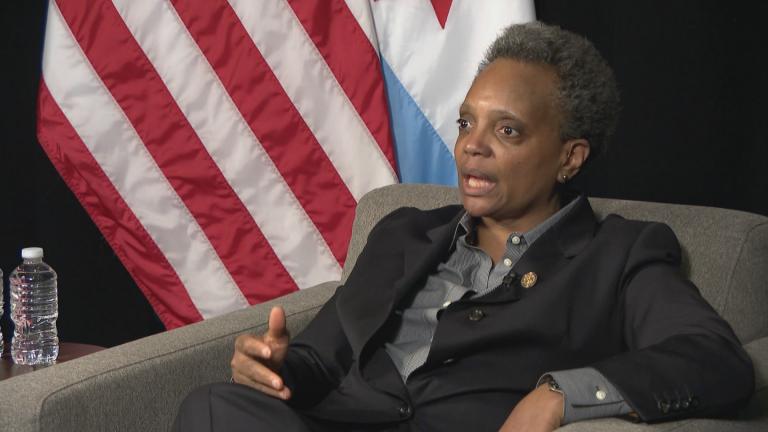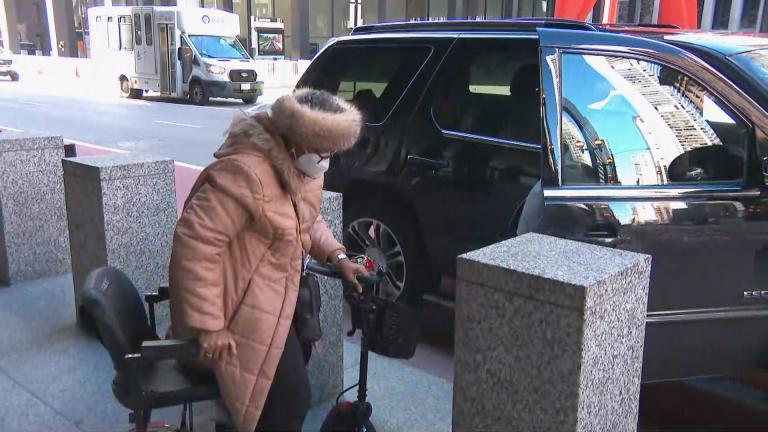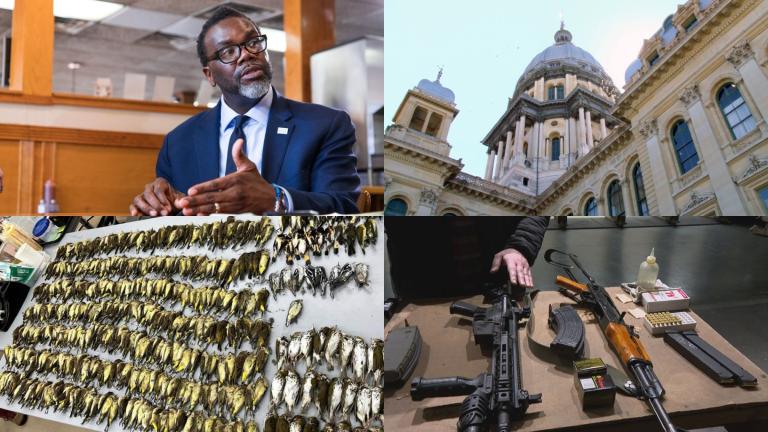VIDEO: Joining “Chicago Tonight” to discuss the commission report on Chicago monuments are Dorene Wiese, president of the American Indian Association of Illinois, and Pasquale Gianni, Avanti Group president with the Joint Civic Committee of Italian Americans. (Produced by Jennifer Cotto)
A commission charged with reviewing Chicago’s more than 500 public monuments as part of a “a racial healing and historical reckoning project” recommended that 13 monuments be removed, including the city’s three statues of Christopher Columbus, in a report released Friday.
The commission, which was formed more than two years ago in the wake of the social justice protests and unrest that erupted after the police murder of George Floyd, also recommended that the city remove the Italo Balbo monument.
Mayor Lori Lightfoot declined to tell WTTW News whether the commission’s now-public recommendation that all three Columbus statues be removed permanently would prompt her to reconsider her position that the statues should be returned to their pedestals.
In March, Lightfoot said the city’s three Columbus statues would be returned to their still-empty pedestals. A safety plan would be needed to protect the statue in Grant Park, Lightfoot told reporters.
In a statement released by her office, Lightfoot thanked Chicago’s Native American and Italian American communities for participating in the commission’s work, but did not address the future of the statues “regarded by many members of the Italian American community as a symbol of cultural pride” but considered “a bitter reminder of centuries of exploitation, conquest and genocide” to members of Chicago’s Native American community, according to the commission’s report.
“What is clear is the history of both communities is intrinsic to our shared Chicago history and the stories of both communities in all of the nuances needs to be told, known and respected by every Chicagoan,” Lightfoot said. “We need to create more opportunities for bridge building which will be to the benefit of us all.”
It is not clear what the next step in the fraught effort to determine the fate of Chicago’s three Columbus statues would be. Lightfoot said only “there are many more steps that will be taken on this long journey toward reckoning, understanding, and healing and I look forward to more dialogue, public engagement and the path forward.”
Ron Onesti of the Joint Civic Committee of Italian Americans called the commission’s recommendations “literally preposterous.”
The city is facing two lawsuits over the removal of the Columbus statute. Chicago’s Joint Civic Committee of Italian Americans wants a judge to rule that the removal of the statue in Little Italy’s Arrigo Park violated a decades-old agreement to display it in perpetuity.
In addition, a former attorney for the Chicago Park District sued the city after he said Lightfoot berated him using obscene language and blocked a deal the Park District made to allow a Columbus statue to be displayed in a parade.
Launched in August 2020, Lightfoot vowed the Chicago Monuments Commission would “provide a vehicle to address the hard truths of Chicago’s racial history” and detail how the city could “memorialize Chicago’s true and complete history.”
By February 2021, the commission had finished reviewing Chicago’s more than 500 public monuments and issued an interim report that flagged 41 monuments as problematic for a variety of reasons, including the statues of four presidents: George Washington, Abraham Lincoln, Ulysses S. Grant and William McKinley.
The commission did not recommend that any of the statues representing former presidents be removed. However, the statues of Washington and McKinley should be prioritized “for permanent and/or ongoing artistic prioritized interventions that will help viewers reconsider the works and their subjects,” according to the report.
The commission also recommended that “Indians (The Bowman and the Spearman)” which stands at the Michigan Avenue entrance of Grant Park, also be placed in its proper context.
“Common to almost all the 41 objects that were identified by this process — most of which were created between 1893 and the late 1930s — is a shared origin in late 19th century values that privilege whiteness, social elites and the powerful above all other people,” according to the commission’s report.
In addition to the Columbus statues, the Balbo Monument, which is near a street named for the Italian aviator, should be removed because it “was a gift of the fascist government of Italy” and Balbo — who also has a Chicago street named after him — “was a leader of the movement’s paramilitary Blackshirts, one of the men who planned the insurrectional march on Rome to install Mussolini as Italy’s dictator and, as colonial governor of Libya, a supporter of Italy’s forced annexation of Ethiopia,” according to the report.
The commission also recommended the removal of the reliefs on the Michigan Avenue bridge over the Chicago River: “The Defense,” “The Pioneers,” “Discoverers” and “Regeneration.”
All four reliefs on the bridge “place the history of Chicago and the Battle of Fort Dearborn within an allegorical narrative of the triumph of Western civilization. American Indians are used as merely a foil to help define the heroic acts and qualities of colonizing forces,” according to the commission report.
However, because the reliefs are part of the structure of the bridge “their detachment without damage (will be) difficult” and “landmark status will also play a role in determining the ultimate disposition of these artworks,” according to the commission’s report.
The commission recommended the city form a working group to consider the future of the reliefs, and in the meantime, endorses “powerful, non-physical and possibly periodic, deactivation or disruption of these works.”
In addition, the commission recommends that two plaques honoring Cavelier De La Salle and Jolliet and Marquette as “the first white men to pass through the Chicago River” should also be removed from the Michigan Avenue bridge because they “explicitly voice the ideology of white supremacy.”
The commission also recommended removing the statue of Marquette and an American Indian near 26th Street and Damen Avenue as well as the Marquette-Jolliet Memorial in Little Village because it “reinforces stereotypes about American Indians and glorifies a complicated and painful history of Western expansion. It features a cowering American Indian, following submissively in the footsteps of Marquette,” according to the report.
A plaque installed on the Chicago Cultural Center honoring Jean Baptiste Pointe DuSable, Chicago’s first non-native settler, should be removed because it “employs specious and arbitrary designations that rank early Chicago settlers (first civilian, second civilian).”
A similar plaque honoring John Kinzie and the birth of the first “white child” should remain in storage because it “openly prioritizes whiteness and denies the existence of Native people,” according to the commission.
A bronze sculpture of the Fort Dearborn Massacre, which the commission describes as “conceived in a sensationalist, luridly violent mode, the sculpture was long criticized by American Indian activists and was removed from public view in 1997” should remain in storage, according to the commission.
The commission also recommends that a monument honoring General Philip Henry Sheridan should “be removed because of scorched-earth tactics against the American Indians,” according to the commission.
In addition, a bust of Melville Fuller should be removed because as chief justice of the U.S. Supreme Court he presided over the nearly unanimous 1896 ruling in Plessy v. Ferguson that enshrined segregation into American law for more than 50 years.
When Lightfoot launched the commission, she decried the fact that Chicago has few public monuments dedicated to women or people of color, and called for that imbalance to be corrected.
Along with the release of the long-delayed report, the Chicago Department of Cultural Affairs and Special Events announced that it would award $50,000 planning grants for the creation of eight monuments:
- A Mahalia Jackson memorial in Chatham
- A monument to historic events and people that have shaped the Latina/x experience in the Pilsen neighborhood
- The Mother Jones Heritage Project
- A monument to honor Jean Baptiste Pointe du Sable and Kitihawa, his wife and a local Potawatomi woman
- The Chicago Torture Justice Memorial
- The Chicago Race Riot of 1919 Commemoration Project
- A Long Walk Home’s “Visibility Project,” which focuses on Black women and girls
- A monument to victims of gun violence in Chicago.
Contact Heather Cherone: @HeatherCherone | (773) 569-1863 | [email protected]








